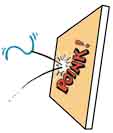Standing Waves
 The first thing we need to understand is what happens when a wave bounces off the wall
of a microwave oven...
The first thing we need to understand is what happens when a wave bounces off the wall
of a microwave oven...
 It bounces off?
It bounces off?
|

|
 Sure, it reflects off the metal wall. That's why it is safe to be near a microwave oven while
it is on; the metal keeps the microwaves in.
Sure, it reflects off the metal wall. That's why it is safe to be near a microwave oven while
it is on; the metal keeps the microwaves in.
 The wave doesn't actually bounce back like a rubber ball. Come with me and I'll explain to
you how the wave changes phase when reflecting off a metal surface.
The wave doesn't actually bounce back like a rubber ball. Come with me and I'll explain to
you how the wave changes phase when reflecting off a metal surface.
|
 But if the waves bounce back, don't they "interfere" with themselves?
But if the waves bounce back, don't they "interfere" with themselves?
 Yup, but that's a useful thing. Take a look at the demonstration below. The two gray waves are
moving in opposite directions, as if they are just bouncing back and forth. The red wave is the
"sum" of the two gray waves as they interfere with each other.
Yup, but that's a useful thing. Take a look at the demonstration below. The two gray waves are
moving in opposite directions, as if they are just bouncing back and forth. The red wave is the
"sum" of the two gray waves as they interfere with each other.
 Cool...the red wave doesn't look like it is moving anywhere, it is just moving up and down.
And if I change the wavelength of the gray waves, the red wave changes with them.
Cool...the red wave doesn't look like it is moving anywhere, it is just moving up and down.
And if I change the wavelength of the gray waves, the red wave changes with them.
 Right. We call this a "standing wave" because it doesn't seem to move. The points on the red
wave that don't even move up and down are called "nodes" and those are the cold spots in
your microwave.
Right. We call this a "standing wave" because it doesn't seem to move. The points on the red
wave that don't even move up and down are called "nodes" and those are the cold spots in
your microwave.
 Why is the red wave taller than the gray waves?
Why is the red wave taller than the gray waves?
 Remember, we're adding the waves together. In fact, we now have to look at what happens
to the red wave as the gray wave bounces back and forth not just once but many, many times...
Remember, we're adding the waves together. In fact, we now have to look at what happens
to the red wave as the gray wave bounces back and forth not just once but many, many times...






